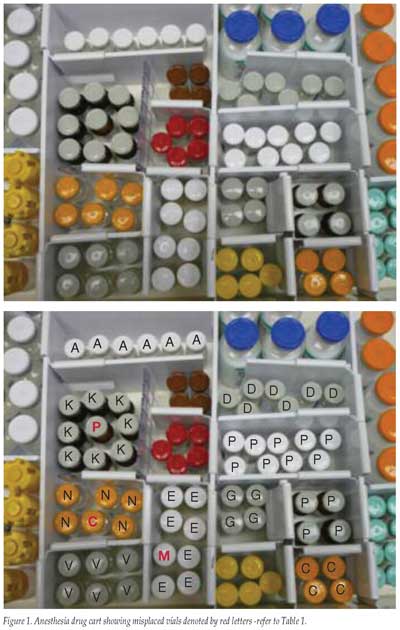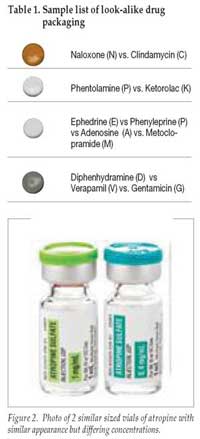Letter to the Editor

In a consumer update dated April 2008, the FDA stated that they have received reports of more than 95,000 medication errors since the year 2000.1 This corresponds to more than 33 medication errors per day. Poor packaging design has been identified as one of the causative factors.
Studies have indicated that most medication errors in anesthesia are due to either preparation or administration of the wrong drug.2 Suggestions to minimize these errors have included careful reading of labels, standardization of labels, and formal organization of drug drawers and workspaces.3
It seems that the vial caps have been ignored. On opening an anesthesia drug cart, the anesthesiologist may get a view of medications similar to that in Figure 1. Although the vial cap is the most visible part of the vial, it typically contains no information about the vial contents. This is due in part to a lack of coordination among different suppliers.
With most anesthesiologists experiencing at least one drug error in their career,4 we suggest that vial cap color be standardized similar to the current syringe labeling system (e.g., bright red for muscle relaxants, purple for vasoactive drugs, etc.). Similar color coding could be used for the label, or for the ink on the label, as well.

Another potential source of confusion is the supplying of varying doses and concentrations of a medication in the same size vial (Figure 2). We suggest that, whenever possible, larger doses and higher concentrations of a medication be supplied in a larger size vial.
- US Food and Drug Administration. United States Department of Health and Human Services. FDA 101: Medication Errors. 2008. Available at: http://www.fda.gov/ consumer/updates/medicationerrors031408.html. Accessed March 18, 2009.
- Abeysekera A, Bergman IJ, Kluger MT, Short TG. Drug error in anaesthetic practice: a review of 896 reports for the Australian Incident Monitoring Study database. Anaesthesia 2005;60:220-7.
- Jensen LS, Merry AF, Webster CS, Weller J, Larsson L. Evidence-based strategies for preventing drug administration errors during anaesthesia. Anaesthesia 2004;59:493-504.
- Orser BA, Chen RJ, Yee DA. Medication errors in anesthetic practice: a survey of 687 practitioners. Can J Anaesth 2001;48:139-46.


 Issue PDF
Issue PDF